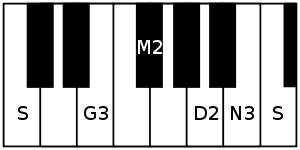Sunadavinodini
| Arohanam | S G₃ M₂ D₂ N₃ Ṡ |
|---|---|
| Avarohanam | Ṡ N₃ D₂ M₂ G₃ S |
| Carnatic music |
|---|
Tanjavur-style Tambura |
| Concepts |
| Compositions |
| Instruments |
|
Sunadavinodini is a rāgam in Carnatic music (musical scale of South Indian classical music). It is an audava rāgam (or owdava rāgam, meaning pentatonic scale). It is a janya rāgam (derived scale), as it does not have all the seven swaras (musical notes). This raga was discovered by Mysore Vasudevachar.
Structure and Lakshana

Sunadavinodini is a symmetric rāgam that does not contain rishabham and panchamam. It is a pentatonic scale (audava-audava ragam [1][2] in Carnatic music classification – audava meaning 'of 5'). Its ārohaṇa-avarohaṇa structure (ascending and descending scale) is as follows (see swaras in Carnatic music for details on below notation and terms):
- ārohaṇa : S G₃ M₂ D₂ N₃ Ṡ[lower-alpha 1]
- avarohaṇa : Ṡ N₃ D₂ M₂ G₃ S[lower-alpha 2]
(notes used in this scale are antara gandharam, prati madhyamam, chathusruthi dhaivatham, kakali nishadham)
Sunadavinodini is considered a janya rāgam of Kalyani, the 65th Melakarta rāgam, though it can be derived from 2 other melakarta rāgams, Gamanashrama or Kosalam, by dropping both rishabham and panchamam.
Popular compositions
Sunadavinodini rāgam lends itself for elaboration and exploration and has many compositions. Here are some popular kritis composed in Sunadavinodini.
- Devadhi deva sri vasudeva by Mysore Vasudevacharya
- Samagana sunadavinodini by G Gururakacharya
- Sanatani sri sunadavinodini by Mrs Kalyani Varadarajan
- Sri Venugopala by Anonymous
- vagadhishvari devi vara-muni-gana-vandite by Bharani
Effect
This raaga can induce the presence of being under parental care for children and experience their affection
Related rāgams
This section covers the theoretical and scientific aspect of this rāgam.
Graha bhedam
Sunadavinodini's notes when shifted using Graha bhedam, yields 2 other pentatonic rāgams, namely, Shivaranjani and Revati. Graha bhedam is the step taken in keeping the relative note frequencies same, while shifting the shadjam to the next note in the rāgam. See Graha bhedam on Shivaranjani for more details and an illustration.
Scale similarities
- Hamsānandi is a popular rāgam which sounds similar to Sunadavinodini and has the shuddha rishabham extra when compared to it. Its ārohaṇa-avarohaṇa structure is S R₁ G₃ M₂ D₂ N₃ Ṡ: Ṡ N₃ D₂ M₂ G₃ R₁ S
- Amritavarshini is another popular rāgam which has the panchamam in place of the dhaivatam when compared to Sunadavinodini. Its ārohaṇa-avarohaṇa structure is S G₃ M₂ P N₃ Ṡ: Ṡ N₃ P M₂ G₃ S